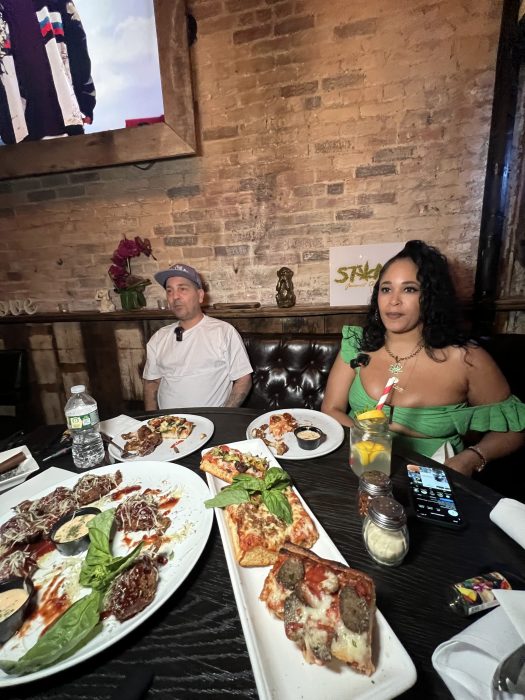Workers at 186 Spring St. may be heading towards demolishing the historic site. GAY CITY NEWS
BY DUNCAN OSBORNE | Arnie Kantrowitz recalled a Thanksgiving at 186 Spring St. when he and other early gay rights activists had “20 guests for dinner.” The meal lasted longer than one day.
“It became an all weekend affair with people wandering in and out of the house,” he said. “Nobody knew who they were. It was a very trusting kind of feeling.”
Kantrowitz lived in building, which was built in 1824, from 1971 to 1973 and he shared the space with Jim Owles and Bruce Voeller who, like Kantrowitz, were leading voices in the early gay rights movement.
Kantrowitz, now 71, was an officer in the Gay Activists Alliance (GAA), an early political group, and a founder of the Gay and Lesbian Alliance Against Defamation (GLAAD).
Owles, who died in 1993, was also a founder of GAA and GLAAD. His 1973 run for City Council made him the first openly gay candidate to run for political office in New York. In 1973, he was a founder of the Gay & Lesbian Independent Democrats (GLID), a political club. Voeller, who died in 1994, was a founder of what is now the National Gay and Lesbian Task Force (NGLTF). He ran the group from 1973 to 1978. He was also in the leadership of the community’s response to AIDS.
“There was political discussion in the house by leaders of the political organizations,” Kantrowitz said. GAA’s Wooster Street headquarters were nearby.
“This building was just a couple of blocks from the Firehouse so it was very convenient,” Kantrowitz said.
Though the four-story house lacked a “charter,” Kantrowitz said, there were aspects of life there that were communal. On every day except Sunday, one member of the household was responsible for preparing dinner and then cleaning up. And the tenants changed over time.
“The cast of characters changed every once in while,” Kantrowitz said. “Somebody would drop out and somebody would drop in,”
The building’s proximity to the Firehouse made socializing and sex that much easier. GAA held regular dances in the Firehouse as an alternative to gay bars that were seen as taking advantage of gay men and lesbians. It was not uncommon “to go fishing in the Firehouse and bring your catch home,” Kantrowitz said.
“Indeed there was a lot of swapping of partners during that big weekend,” he said. “There was a lot of sex going on. You have to remember what the era was like. Sexuality was very free and foremost in our minds.”
A rendering of the condominiums that will replace 186 Spring St., a building that was home to some early gay activists. GAY CITY NEWS
A company, Nordica Development, wants to build “luxury loft-style condominiums” on the site and that will require that 186 Spring St. be demolished. That has drawn objections from the Greenwich Village Society for Historic Preservation which asked in 2006 that a large part of the South Village be designated a historic district.
“We’ve been asking the city to do something about this area for years now,” said Andrew Berman, the society’s executive director. Generally, the city has not protected sites that have historic value to the lesbian, gay, bisexual, and transgender community.
“The current [Landmarks Preservation Commission] has shown very little interest in protecting or recognizing the city’s LGBT history,” Berman said. “There is definitely no site in New York City that is designated because of its importance to LGBT history.”
The Stonewall bar on Christopher Street, the site of the 1969 riots that are seen as launching the modern gay rights movement, is a state and federal landmark, but New York City has not protected it.
“The state of New York and the federal government have recognized that the site is of importance to LGBT history, but our very own Landmarks Preservation Commission has not,” Berman said.
GLID, NGLTF, the Jim Owles Liberal Democratic Club, a political group, and openly-gay elected officials, including City Council Speaker Christine Quinn, state Senator Thomas Duane, and Assemblymember Deborah Glick, have opposed the demolition of 186 Spring St.
The commission declined to landmark the building after deciding that few of its original elements remain though it is now weighing the connection to the gay rights movement.
“Subsequent to this determination, we received information about the building’s connection to the gay rights movement,” Elisabeth de Bourbon, the commission’s spokesperson, wrote in an email. “We are going to weigh those associations in the context of the building's architectural characteristics and will make a decision as soon as possible on whether to recommend it to the full commission.”
For Kantrowitz, protecting the site is an obvious choice. He said “It’s part of the story of New York.”
The construction on the site is moving forward. Stephane Boivin, the president of Nordica, did not respond to an email and calls seeking comment.



































